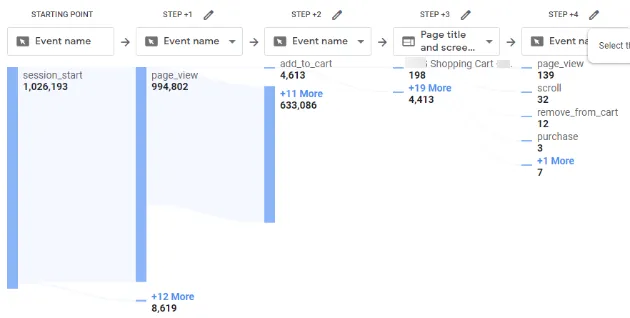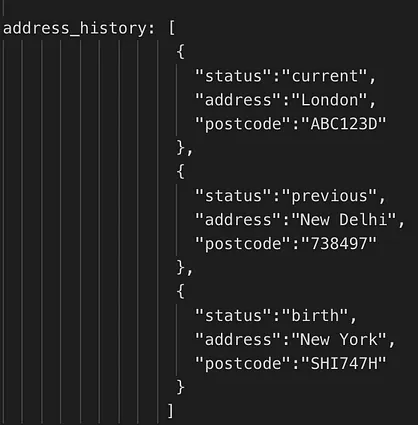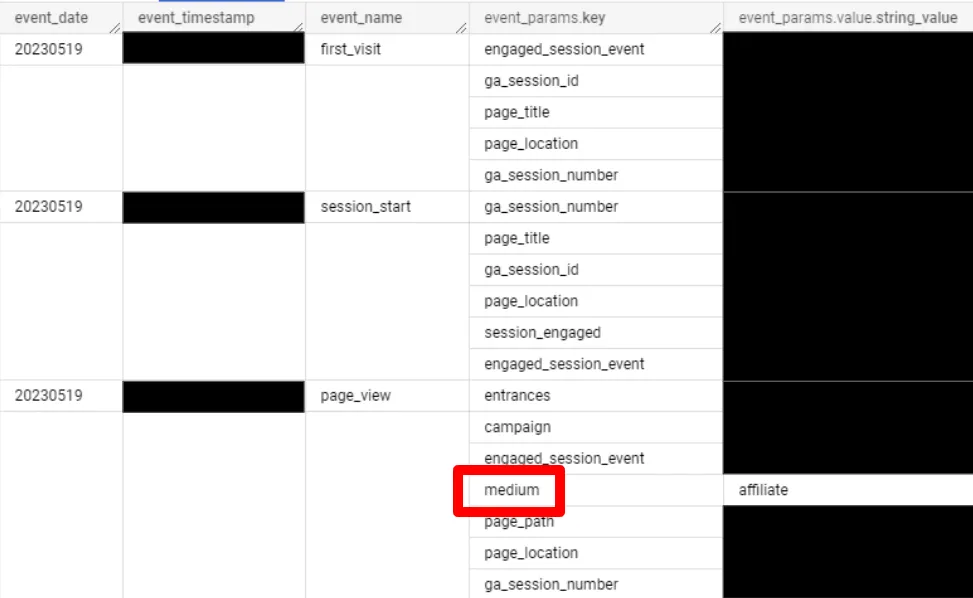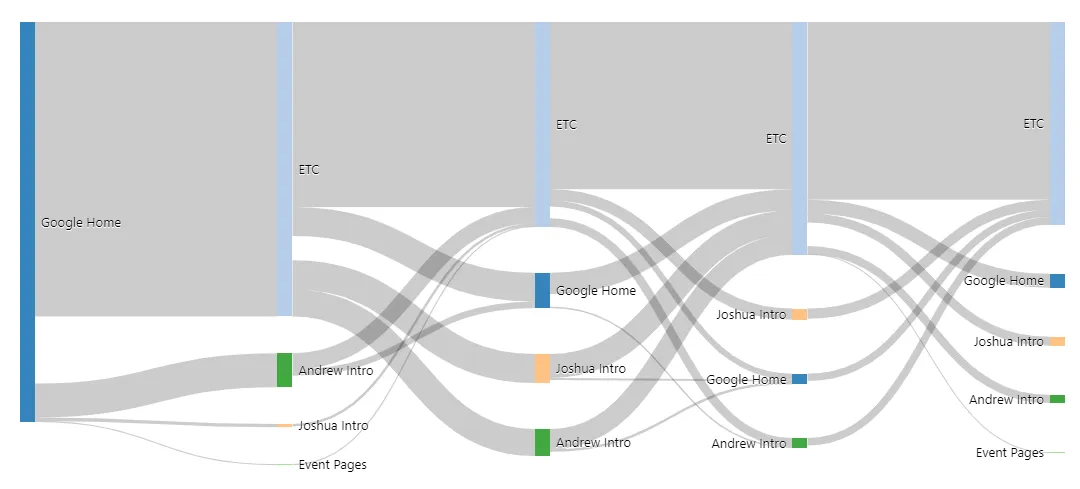Let’s Create the Sankey Chart
In this article, I’m going to tell you how you can create the Sankey Chart starting from GA4, BigQuery, and up to Redash.
CONTENTS
- Introduction
- Flatten the source table.
- Make sure each user and session has the same properties(or parameters).
- Delete the consecutive same page URL duplicates in the same
session_id. - Label each page’s visiting order number for each session.
- Categorize all the pages.
- Pivot each session’s journey up to 10 steps.
- Make the query result compatible with Redash.
- Final Result
- Conclusion

Data Pipeline from the website all the way up to Redash
1. Introduction
1.1. What is Sankey Chart?

Sankey Chart, oftentimes also called Sankey Diagram, is a type of flow visualization in which the width of the arrows is proportional to the flow rate of the depicted extensive property. [Wikipedia]
1.2. Why is Sankey Chart Important in Data Analytics?
In the Data Analytics world, though, we can figure out how our visitors make their journey throughout our website pages or app screens. With the Sankey Chart, we can apply our strategies as shown below.
- “Many purchasing visitors mainly make a journey starting from
page A,page B,page C, and finally make their purchase. Therefore, we might be able to create a CTA button in order to drive the other visitors to this journey, so that we could make our revenue much higher.” - “
Page AandPage Bare the points where our visitors bounce off the most. Bet those two pages have some problems in terms of psychology or technology. Let’s now dive into specific user interviews or research to deal with this bounce-off rate.”
1.3. Limitations of Google Analytics 4
Although GA4 supports some custom visualizations and you can explore the path analysis to figure out how your visitors take their journey throughout the websites, it’s literally awful and much of a hassle if you’re eager to get some insights regarding that. (See below how awful it is.)

Now that hopefully you got deeply understood what is the Sankey Chart and why it’s important in product analytics, it’s time to show you how to create the Sankey Chart from A to Z. Let’s directly dive into it!
2. Flatten the source table.
Although it’s really handy to connect the GA4 events to BigQuery, there’s a complicated issue hard to handle; Some of the datatypes imported to BigQuery are STRUCT type. It’s regarded as an array type, or you can imagine this as a STRUCT type column that allows each row to have a multiple-dimensional value in it.


You can simply use UNNEST to flatten each STRUCT type column in advance of your main query.
2.1. The Entire Codes
WITH
CTE_flattened AS (
SELECT
event_date,
event_timestamp,
user_pseudo_id,
ga_session_id.value.int_value AS session_id,
ga_session_number.value.int_value AS session_number,
event_name,
page_location.value.string_value AS page_location,
ecommerce.purchase_revenue_in_usd AS revenue_usd,
geo.country,
device.category AS device,
utm_campaign.value.string_value AS utm_campaign,
utm_medium.value.string_value AS utm_medium,
utm_source.value.string_value AS utm_source,
page_referrer.value.string_value AS page_referrer
FROM
`your_table.events_*`
LEFT JOIN
UNNEST (event_params) AS ga_session_id
ON ga_session_id.key = 'ga_session_id'
LEFT JOIN
UNNEST (event_params) AS ga_session_number
ON ga_session_number.key = 'ga_session_number'
LEFT JOIN
UNNEST (event_params) AS page_location
ON page_location.key = 'page_location'
LEFT JOIN
UNNEST (event_params) AS utm_campaign
ON utm_campaign.key = 'campaign'
LEFT JOIN
UNNEST (event_params) AS utm_medium
ON utm_medium.key = 'medium'
LEFT JOIN
UNNEST (event_params) AS utm_source
ON utm_source.key = 'source'
LEFT JOIN
UNNEST (event_params) AS page_referrer
ON page_referrer.key = 'page_referrer'
WHERE
_table_suffix BETWEEN
FORMAT_DATE(
'%Y%m%d',
DATE_SUB(CURRENT_DATE(), INTERVAL 90 DAY)
)
AND
FORMAT_DATE(
'%Y%m%d',
CURRENT_DATE()
)
AND ga_session_number.value.int_value = 1
AND user_pseudo_id IS NOT NULL
AND ga_session_id IS NOT NULL
),
2.2. Detailed Explanation of Key Codes
LEFT JOIN
UNNEST (event_params) AS ga_session_id
ON ga_session_id.key = ‘ga_session_id’
- Each
eventmay havega_session_idin its parameters, and we have to grab it in order to follow through each user session’s journey based on thega_session_id.
LEFT JOIN
UNNEST (event_params) AS ga_session_number
ON ga_session_number.key = ‘ga_session_number’
- Each
eventmay havega_session_numberin its parameters, and we have to look through it in order to know if eachsessionis the first visiting user’s or returning user’s session.
LEFT JOIN
UNNEST (event_params) AS page_location
ON page_location.key = ‘page_location’
- Most of each
eventhaspage_locationin its parameters, and of course, we have to knowpage_locationin order to follow through with their journey based on the page URL.
LEFT JOIN
UNNEST (event_params) AS utm_campaign
ON utm_campaign.key = ‘campaign’
- Many times, each
sessionhas a totally different shape of the journey depending on what kind of campaign channel the session has started from. Therefore, let’s also queryutm_campaignjust in case.
LEFT JOIN
UNNEST (event_params) AS utm_medium
ON utm_medium.key = ‘medium’
- Many times, each
sessionhas a totally different shape of the journey depending on what kind of medium channel the session has started from. Therefore, let’s also queryutm_mediumjust in case.
LEFT JOIN
UNNEST (event_params) AS utm_source
ON utm_source.key = ‘source’
- Many times, each
sessionhas a totally different shape of the journey depending on what kind of source channel the session has started from. Therefore, let’s also queryutm_sourcejust in case.
LEFT JOIN
UNNEST (event_params) AS page_referrer
ON page_referrer.key = ‘page_referrer’
- Many times, each
sessionhas a totally different shape of the journey depending on exactly what previous page URL the session has started from. Therefore, let’s also querypage_referrerjust in case.
AND ga_session_number.value.int_value = 1
AND user_pseudo_id IS NOT NULL
AND ga_session_id IS NOT NULL
- Here, I wanted to know specifically about the first visiting users’ journey, and that’s why I try to query with
ga_session_numberonly as1. - We basically have to track the
user_pseudo_idandga_session_idin order to make sure each user journey has been there from the same user and same session. That’s why I dropped all the missinguser_pseudo_idandga_session_idinstances.
3. Make sure each user and session has the same properties(or parameters).
Sometimes, even though it’s rooted in the same session_id, some events have their parameters fully, but others don’t. That’s why we make duplicates for the parameters throughout the same user_pseudo_id and session_id.

This is a real BigQuery table appended from GA4, and you can look only one event has the medium value.
3.1. The Entire Codes
You can use FIRST_VALUE and LAST_VALUE functions to make the duplicates.
CTE_properties_spread AS (
SELECT
event_date,
event_timestamp,
user_pseudo_id,
session_id,
session_number,
event_name,
REGEXP_REPLACE(
REGEXP_REPLACE(
LOWER(page_location),
r'(\?.*)$', ''
),
r'/$', ''
) AS page_location,
revenue_usd,
FIRST_VALUE(country) OVER(
PARTITION BY user_pseudo_id, session_id
ORDER BY event_timestamp
) AS country,
FIRST_VALUE(device) OVER(
PARTITION BY user_pseudo_id, session_id
ORDER BY event_timestamp
) AS device,
LAST_VALUE(utm_campaign) OVER(
PARTITION BY user_pseudo_id, session_id
ORDER BY event_timestamp
) AS utm_campaign,
LAST_VALUE(utm_medium) OVER(
PARTITION BY user_pseudo_id, session_id
ORDER BY event_timestamp
) AS utm_medium,
LAST_VALUE(utm_source) OVER(
PARTITION BY user_pseudo_id, session_id
ORDER BY event_timestamp
) AS utm_source,
LAST_VALUE(
REGEXP_REPLACE(
REGEXP_REPLACE(
LOWER(page_referrer),
r'(\?.*)$', ''
),
r'/$', ''
)
) OVER(
PARTITION BY user_pseudo_id, session_id
ORDER BY event_timestamp
) AS page_referrer
FROM
CTE_flattened
),
3.2. Detailed Explanation of Key Codes
REGEXP_REPLACE(
REGEXP_REPLACE(
LOWER(page_location),
r'(\?.*)$', ''
),
r'/$', ''
) AS page_location,
- Many times, the page URL has different shapes even though it drives the visitors to the exact same page.
- The four URLs below have different values, but they direct you to the same Google main page anyways.
- That’s why I use the
REGEXP_REPLACEfunction to drop the useless letters in data analytics.
FIRST_VALUE(country) OVER(
PARTITION BY user_pseudo_id, session_id
ORDER BY event_timestamp
) AS country
- Because of some technical problems, one user and session might have multiple countries. (I’m guessing some users might have moved overseas, changed IP Address through VPNs, or GA4’s tech issue itself.) Regarding this issue, I would make a decision to grab the very first country value to know where the
userandsessionhave started. - Let’s assume a visitor is aboard a plane, and when he/she starts the session the plane is located in the US, but when visiting the following page, the plane has just entered the Canada area. In this extreme case, we’d rather think of this visitor as starting from the US.
4. Delete the consecutive same page URL duplicates in the same session_id.
In most cases, if a visitor lands on page A, multiple events can happen.
- i.e.,
session_start,page_view,user_engagement,scroll, and whatnot
We need to delete all the same Page URLs triggered consecutively in one session, but only with the unique page URL.
4.1. The Entire Codes
CTE_unique_pages AS (
SELECT
event_date, event_timestamp,
user_pseudo_id, session_id, session_number,
event_name,
page_location,
LAG(page_location) OVER(
PARTITION BY user_pseudo_id, session_id
ORDER BY event_timestamp
) AS previous_page_location,
LEAD(page_location) OVER(
PARTITION BY user_pseudo_id, session_id
ORDER BY event_timestamp
) AS next_page_location,
revenue_usd,
country, device,
utm_campaign, utm_medium, utm_source, page_referrer
FROM (
SELECT
*,
CASE
WHEN -- Previous URL IS NULL
previous_page_location IS NULL THEN 'remain'
WHEN -- Previous URL <> Current URL
previous_page_location <> page_location THEN 'remain'
WHEN -- Previous URL = Current URL
previous_page_location = page_location
AND page_location <> next_page_location THEN 'del'
END AS remain_or_del
FROM (
SELECT
event_date, event_timestamp,
user_pseudo_id, session_id, session_number,
event_name,
page_location,
LAG(page_location) OVER(
PARTITION BY user_pseudo_id, session_id
ORDER BY event_timestamp
) AS previous_page_location,
LEAD(page_location) OVER(
PARTITION BY user_pseudo_id, session_id
ORDER BY event_timestamp
) AS next_page_location,
revenue_usd,
country, device,
utm_campaign, utm_medium, utm_source, page_referrer
FROM CTE_properties_spread
)
)
WHERE
remain_or_del = 'remain'
ORDER BY
user_pseudo_id, session_id, event_timestamp
),
Here in the query above, I used LAG and LEAD window functions to know whether to delete duplicates based on the previous page URL and the next page URL.
5. Label each page’s visiting order number for each session.
We can Label visit_order for each page URL based on the event_timestamp in ascending order.
- Here, I used the
ROW_NUMBERwindow function to do it.
5.1. The Entire Codes
CTE_visit_orders AS (
SELECT
event_date, event_timestamp,
user_pseudo_id, session_id,
page_location,
ROW_NUMBER() OVER(
PARTITION BY user_pseudo_id, session_id
ORDER BY event_timestamp
) AS visit_order,
country, device,
utm_campaign, utm_medium, utm_source, page_referrer
FROM
CTE_unique_pages
ORDER BY
user_pseudo_id, session_id, visit_order
),
6. Categorize all the pages.
The page URL itself looks dirty since it’s not that human-readable, so here I wanted to categorize all the pages existing in the whole domain to make them literally human-readable.
6.1. The Entire Codes
CTE_page_groups AS (
SELECT
event_date, event_timestamp,
user_pseudo_id, session_id,
page_location,
CASE
WHEN page_location = 'https://google.com' THEN 'Google Home'
WHEN page_location = 'https://google.com/joshua' THEN 'Joshua Intro'
WHEN page_location = 'https://google.com/andrew' THEN 'Andrew Intro'
WHEN page_location = 'https://google.com/amber' THEN 'Amber Intro'
WHEN CONTAINS_SUBSTR(page_location, 'https://google.com/policy') = True THEN 'Policy Pages'
WHEN CONTAINS_SUBSTR(page_location, 'https://google.com/events') = True THEN 'Event Pages'
ELSE 'ETC'
END AS page_group,
visit_order,
country, device,
utm_campaign, utm_medium, utm_source, page_referrer
FROM
CTE_visit_orders
ORDER BY
user_pseudo_id, session_id, visit_order
),
7. Pivot each session’s journey up to 10 steps.
7.1. The Entire Codes
CTE_journeys AS (
SELECT
user_pseudo_id, session_id,
country, device,
utm_campaign, utm_medium, utm_source, page_referrer,
MAX((SELECT page_group FROM CTE_page_groups SUB
WHERE MAIN.user_pseudo_id = SUB.user_pseudo_id AND MAIN.session_id = SUB.session_id AND visit_order = 1)) AS step01,
MAX((SELECT page_group FROM CTE_page_groups SUB
WHERE MAIN.user_pseudo_id = SUB.user_pseudo_id AND MAIN.session_id = SUB.session_id AND visit_order = 2)) AS step02,
MAX((SELECT page_group FROM CTE_page_groups SUB
WHERE MAIN.user_pseudo_id = SUB.user_pseudo_id AND MAIN.session_id = SUB.session_id AND visit_order = 3)) AS step03,
MAX((SELECT page_group FROM CTE_page_groups SUB
WHERE MAIN.user_pseudo_id = SUB.user_pseudo_id AND MAIN.session_id = SUB.session_id AND visit_order = 4)) AS step04,
MAX((SELECT page_group FROM CTE_page_groups SUB
WHERE MAIN.user_pseudo_id = SUB.user_pseudo_id AND MAIN.session_id = SUB.session_id AND visit_order = 5)) AS step05,
MAX((SELECT page_group FROM CTE_page_groups SUB
WHERE MAIN.user_pseudo_id = SUB.user_pseudo_id AND MAIN.session_id = SUB.session_id AND visit_order = 6)) AS step06,
MAX((SELECT page_group FROM CTE_page_groups SUB
WHERE MAIN.user_pseudo_id = SUB.user_pseudo_id AND MAIN.session_id = SUB.session_id AND visit_order = 7)) AS step07,
MAX((SELECT page_group FROM CTE_page_groups SUB
WHERE MAIN.user_pseudo_id = SUB.user_pseudo_id AND MAIN.session_id = SUB.session_id AND visit_order = 8)) AS step08,
MAX((SELECT page_group FROM CTE_page_groups SUB
WHERE MAIN.user_pseudo_id = SUB.user_pseudo_id AND MAIN.session_id = SUB.session_id AND visit_order = 9)) AS step09,
MAX((SELECT page_group FROM CTE_page_groups SUB
WHERE MAIN.user_pseudo_id = SUB.user_pseudo_id AND MAIN.session_id = SUB.session_id AND visit_order = 10)) AS step10
FROM CTE_page_groups MAIN
GROUP BY
user_pseudo_id, session_id,
country, device,
utm_campaign, utm_medium, utm_source, page_referrer
ORDER BY
step01, step02, step03, step04, step05,
step06, step07, step08, step09, step10
),
8. Make the query result compatible with Redash.
Since Redash Sankey Chart has its expected framework and naming rules of the query result, we need to make the final query result in order to fit the rule.

Redash Sankey Chart’s Constraints
8.1. The Entire Codes
SELECT
step01 AS stage1,
step02 AS stage2,
step03 AS stage3,
step04 AS stage4,
step05 AS stage5,
COUNT(*) AS value
FROM
CTE_sankey
GROUP BY
step01, step02, step03, step04, step05
HAVING
step01 = 'Google Home'
AND value >= 100
ORDER BY
value DESC
;
8.2. Detailed Explanation of Key Codes
HAVING
step01 = ‘Google Home’
AND value >= 100
- I just wanted to see how the users make their journey who is starting from Google Home.
- To make the visualization look simple and not distracting, I ordered the query to show me the types of user journeys of at least 100 users.
9. Final Result

Redash returns this kind of Sankey Chart.
10. Conclusion
- Redash Sankey Chart is much more valuable specifically when you try to figure out how the users make their journey depending on their countries, devices, UTM parameters, referrer pages, and stuff like that.
- It’s superbly complicated to query, but once you make the whole framework queries to return the Sankey table, I believe you can generate more value to do as many actions as possible which wouldn’t have been possible to do before.
- Nevertheless, Redash Sankey Chart only supports up to
5 steps, which by that means if your website or app has too many pages and screens, it wouldn’t be enough to look through only 5 steps.
Published by Joshua Kim
